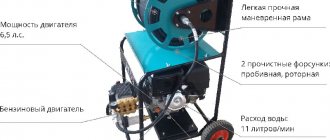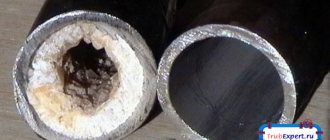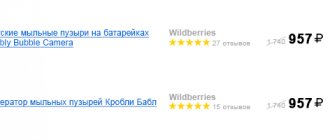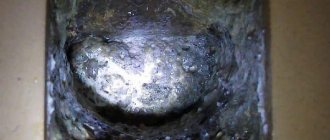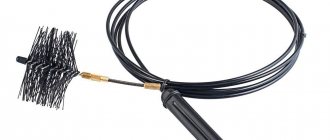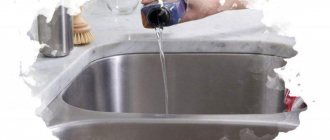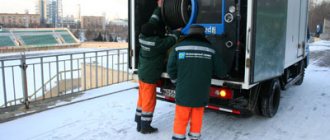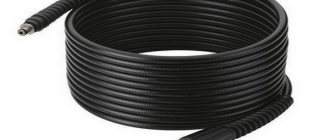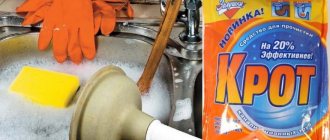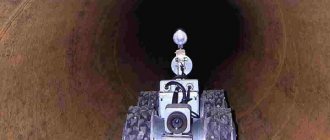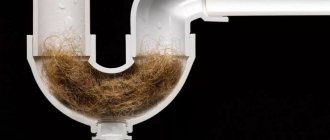Types of sewer blockages
Blockages form for various reasons. This may be the negligence of the owner, who regularly pours greasy waste and large particles of household garbage into the sewer, or the inevitable natural growth of deposits during operation.
It is customary to distinguish the following types of blockages:
- Mechanical. There was construction debris and other foreign objects in the sewer.
- Operational. Particles of food waste, grease, hair or other small particles gradually accumulate on the inner surface of the pipeline walls.
- Mineral. Rust and lime deposits. Rust can form a blockage exclusively in a metal pipeline, while limescale deposits can be deposited on any materials. The rate of growth of lime deposits directly depends on the quality of the water.
It is important! Cast iron drains are considered to be the most prone to blockages. The material of such a pipeline is porous, and particles of grease and dirt easily settle on it. Plastic pipelines are less susceptible to this unpleasant phenomenon.
Methods for cleaning pipes when sewerage is clogged
The vast majority of homeowners prefer to use old, proven (although not always effective) methods to deal with sewer blockages:
- Using a plunger. The simplest method to use, which, however, can only help against small blockages.
- The use of special chemical reagents that decompose organic compounds. The method is effective, but it is undesirable to use it for plastic pipelines, which may simply not withstand aggressive chemical exposure.
- Mechanical cleaning with a special plumbing cable. In pipelines made of plastic materials, this cleaning method should also be used with caution. In addition, flexible cable will be difficult to use in pipelines with a large number of bends or turns.
- Folk recipes. Using salt, soda and vinegar in various proportions.
Note! None of the considered methods guarantees complete cleaning of the pipeline. The length of the cleared area will most likely be small.
Nowadays, the most effective cleaning technology is the use of hydrodynamic units.
We recommend that you familiarize yourself with: Sewer pipes, their types and installation rules
The units are produced in several variations - from professional to compact (household). The former are distinguished by their impressive size and often operate on the basis of vehicles. The scope of application of such units is large main pipelines.
The latter are small devices that can be operated by one person. Such installations are suitable for servicing private households, apartments, and offices.
Hydrodynamic cleaning technology
Hydrodynamics for sewer flushing involves careful treatment of the internal walls of the sewer with water supplied under high pressure (this figure is 100-200 atmospheres). This pressure has an effect on the pipe walls similar to treatment with a stiff brush.
At the end of the flushing, the pipe returns to the quality of a new product. In addition to this, plaque will accumulate much more slowly on a renewed smooth surface.
The design of the hydrodynamic installation is very simple. The device consists of several elements:
- Water compressor.
- Drive: for small household installations – electric. Bulky professional devices are often self-contained and powered by a gasoline or diesel engine.
- A hose through which water is supplied under pressure.
- Tip with nozzle.
Before starting the cleaning procedure, the optimal pressure level for the pipeline is set. In household networks, this figure, as a rule, should not exceed 150 atmospheres. Higher values are fraught with damage at pipeline joints.
Next, the end of the hose with the nozzle is placed into the pipe through a special inspection hatch, toilet drain, or other suitable hole. The compressor is connected to the power source, and liquid begins to flow under pressure. Powerful jets of water propel the hose along the pipe, simultaneously destroying any blockages that get in its way. The installation operator can control the passage of the installation and, if necessary, adjust the pressure level.
After eliminating the blockage (at this moment the accumulated water will begin to quickly drain), it is worth running the unit several times along the same section in order to thoroughly clean the problem area.
We recommend that you read: How to make a homemade pipe bender for a profile pipe - a complete guide with drawings
Types of products
Flushing nozzles are divided according to design features and depending on the nature and location of the blockage.
Separation by operating principle
A blockage in sewer lines is formed from substances with different compositions and is concentrated in different parts of the pipe. Depending on this, after the television inspection, an element is selected that can remove the obstacle most effectively. He can be:
- bottom - used to eliminate sand, silt and dirt, which most often settle to the bottom of the pipe;
- rotary - removing fatty deposits from the walls due to rotation (the higher the speed of movement, the more effective the cleaning);
- penetrating – capable of removing the toughest clogs;
- chain-carousel - coping with compressed sediments.
There are also universal nozzles suitable for all types of blockages.
Classification by design
Nozzles are made with different types of heads, some consisting of several structural elements. The following models are in demand among professionals:
- Direct. Suitable for primary punching of corks, as they allow large remnants of paper, fabric, and food to be pulled out.
- Pear-shaped. Used to clean in places where there are bends.
- Triangular. Remove dense barriers by sawing, cutting and drilling.
- Garnet-shaped. They are used for complex cleaning of pipelines with a cross-section of up to 300 mm under high pressure.
- Parts with slides. Thanks to the nozzles, they can cut roots, fatty and mineral deposits.
- Wedge-shaped. Bottom nozzles usually come in this shape. They are chosen not only for cleaning sand and silt, but also for processing large highways and moving heavy residues.
Steel cutters are also effective for cleaning sewer pipes. They are equipped with replaceable ceramic heads. Thanks to the high rotation speed (6000 rpm), such parts save the pipeline in emergency conditions. Quick insertion of a cutter into a blockage formed by roots, dirt and grease leads to its delamination and further washing out with a water jet in the shortest possible time.
Types of nozzles for hydrodynamic installation
The efficiency of the hydrodynamic machine in each specific case directly depends on the correct choice of nozzle. There are several types of nozzles:
- Universal. Best suited for servicing short-distance domestic sewer networks. Universal nozzles provide good maneuverability, which allows cleaning to be carried out in the shortest possible time.
- Rotary. During operation, the nozzle rotates around its axis, due to which jets of water act on blockages at constantly changing angles. Effective in the fight against fat deposits.
- Garnet-shaped. Area of application: large-diameter main pipelines. They feature a powerful cleaning jet and increased traction.
- Triangular. Designed for complex blockages that cannot always be dealt with using universal nozzles. Due to its shape, the cutting and sawing effect of the pointed edges is added to the effect of water jets.
- Bottom. Designed for cleaning drainage systems and storm sewers, where sediments mostly accumulate at the bottom of the pipeline. The shape of the nozzle resembles a thickened spatula, equipped with a wedge-shaped end with nozzles.
Note! The kit should definitely have a universal nozzle. It (albeit with less functionality) can replace any other.
The nozzles also differ in the number of jets. There can be one jet (central), or several, evenly distributed on the front of the device.
Any nozzle is equipped with direct and reverse type nozzles. The first ones throw out jets of water along the direction of movement, and are responsible for clearing blockages. Secondly, the liquid jets are directed backwards, providing the installation with the jet thrust necessary to move through the pipeline.
Advantages and disadvantages of hydrodynamic sewer cleaning under pressure
This method is usually used to remove blockages in sewer pipes. However, the hydrodynamic method is also relevant for cleaning the following structures:
- water pipes;
- heating pipes and heat exchangers;
- storm sewer pipes;
- drainage devices;
- wells and wells from overflow.
It is possible to eliminate the occurrence of mechanical blockages by installing a food waste shredder. This is a design whose operating mechanism is aimed at preventing foreign objects from entering the pipeline. Advantages of hydrodynamic pipe cleaning over other methods:
- The inner surface of the pipes is cleaned, unlike the work of a plunger or cable. These devices only push the lump itself, but the plaque on the walls does not disappear anywhere and the likelihood of the blockage reoccurring is high;
- the hydrodynamic flushing method cleans the pipeline along its entire length, and for example, a plumbing cable can only deal with blockages in a certain area;
- specialized, professional equipment carefully affects communications and eliminates the risk of damage;
- Suitable for the most severe blockages. Dissolution by chemical means brings results, but the efficiency of the hydrodynamic method is many times higher. It is especially important to note that caustic chemicals are not suitable for plastic pipes, and the water hammer method is safe for all types of pipelines;
- speed in work. It will take no more than half a day for a country house, and about an hour for an apartment;
- any bends in communications are not an obstacle to cleaning; a distance of up to 50 m is quite acceptable.
- In a country house, you can clean not only the sewer system, but also the storm water system. You cannot fill the storm drain with chemicals, as this water will then be unsuitable for use. In particular, it is prohibited to clean drinking water wells with chemical solutions;
- You can break through icy traffic jams in suburban communications during the cold season. In order to remove ice jams, it is enough to supply hot water through a hydrodynamic device. This is an undoubted advantage of the method, since neither a plumbing cable nor chemicals can cope with an ice lump.
Also, turning on hot water can clean fat deposits from the inner walls of the pipeline.
The disadvantage of this cleaning method is the purchase of the necessary equipment and the high cost of specialist services. Hydrodynamic sewer cleaning differs in cost depending on the type of communication:
- external sewer system (main) – 110 rubles. per linear meter;
- internal – 100 rub. for 1 linear meter;
- general (comprehensive) – 100 rub. for 1 linear meter;
- storm water – 90 rub. for 1 linear meter.
The price for hydrodynamic sewer cleaning may seem impressive, but the resulting cleaning result will last up to 10 years.
Advantages and disadvantages of the method
The use of hydrodynamic installations has a number of undeniable advantages:
- The inner walls of the pipes are not damaged. The pressure of water, even such a strong one, is not capable of harming solid material.
- The cleaning procedure takes relatively little time. For a standard apartment, one hour will be enough; completely cleaning the sewer in a large private house will take 3-4 hours.
- No harmful chemical compounds are used during the work.
- After hydrodynamic flushing, the throughput of the pipeline increases to its original level. Other methods do not guarantee such a result.
- The hose of the hydrodynamic unit bends easily, which makes it possible to equally successfully use it both on straight and on turning sections.
- The device is able to function effectively at subzero temperatures, when other cleaning methods will be powerless due to ice jams. Here it will be enough to simply supply hot water to the device.
- The hydrodynamic machine not only removes blockages, but completely flushes the pipeline.
We recommend that you read: How to install water supply for personal use and watering at the dacha using HDPE pipes with your own hands
Among the negative aspects are the high financial costs of carrying out the procedure (however, it is not necessary to buy a flushing system - you can rent it, or order a similar service from specialists). In addition, the device consumes large volumes of water. Thus, to clean large main pipelines, about 300 liters of water per minute will be required. Economical household models consume about 20 liters per minute.
In order to avoid having to deal with the problem of blockages for as long as possible, you should use your sewer system as carefully as possible. It is worth installing a grate at each drain hole to retain large particles of debris. To combat fat deposits, you need to regularly pour hot water down the drain with the addition of special chemicals.
The principle of the method of hydrodynamic cleaning of sewer pipes
The hydrodynamic method of removing blockages is carried out using a specialized device. A hose with the required nozzle is immersed into the hole in the pipe of the area under study. After which water is supplied under high pressure and breaks up the formed lump.
Video diagnostics of pipes: stages and features of implementation
Read more
Water shoots out of a hose nozzle at a speed of 350 m/s. The holes located in the nozzle form the necessary traction so that the nozzle can move independently along the pipe. The impressive water pressure destroys the accumulated blockage, removes plaque from the internal surfaces of the pipe and removes the contents to the drain.
The jet temperature can be any. But to clean grease deposits, it is more effective to use hot water pressure.
The hydrodynamic method is suitable for metal and plastic pipes.
